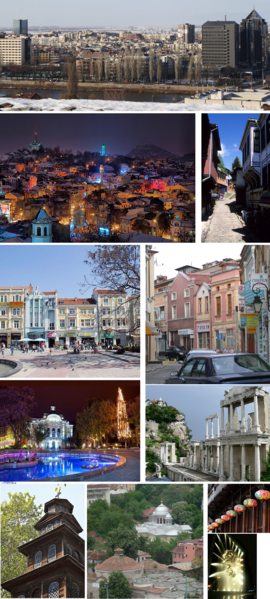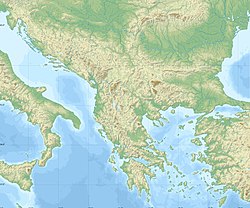
Back Plovdiv AN بلوفديف Arabic پلوڤديڤ ARZ Plovdiv AST Plovdiv Azerbaijani پلودیو AZB Пловдив Bashkir Plovdiv BCL Плоўдзіў Byelorussian Плоўдзіў BE-X-OLD
Plovdiv
Пловдив | |
|---|---|
 From top, left to right:
Hills of Plovdiv • Ancient theatre • Ancient stadium • Historical Museum • Hisar Kapia • Ethnographic Museum • Tsar Simeon's garden • | |
| Nickname(s): The city of the seven hills Градът на седемте хълма (Bulgarian) Gradăt na sedemte hălma (transliteration) | |
| Motto(s): | |
| Coordinates: 42°9′N 24°45′E / 42.150°N 24.750°E | |
| Country | Bulgaria |
| Province | Plovdiv |
| Municipalities | Plovdiv-city |
| Government | |
| • Mayor | Kostadin Dimitrov (GERB) |
| Area | |
| • Total | 101.98 km2 (39.37 sq mi) |
| Elevation | 164 m (538 ft) |
| Population (31 December 2018)[3] | |
| • Total | 346,893 |
| • Urban | 544,628[1] |
| • Metro | 675,586[2] |
| Demonym | Plovdivchanin/Plovdivchanka |
| Time zone | UTC+2 (EET) |
| • Summer (DST) | UTC+3 (EEST) |
| Postal code | 4000 |
| Area code | (+359) 032 |
| Car plates | PB |
| Website | www.plovdiv.bg |
Plovdiv (Bulgarian: Пловдив, pronounced [ˈpɫɔvdif]) is the second-largest city in Bulgaria, 93 miles southeast of the capital Sofia. It had a population of 346,893 as of 2018[update] and 675,000 in the greater metropolitan area. Plovdiv is a cultural hub in Bulgaria and was the European Capital of Culture in 2019. The city is an important economic, transport, cultural, and educational centre. Plovdiv joined the UNESCO Global Network of Learning Cities in 2016.
Plovdiv is in a fertile region of south-central Bulgaria on the two banks of the Maritsa River. The city has historically developed on seven syenite hills, some of which are 250 metres (820 feet) high. Because of these hills, Plovdiv is often referred to in Bulgaria as "The City of the Seven Hills". There is evidence of habitation in the area dating back to the 6th millennium BCE, when the first Neolithic settlements were established. The city was subsequently a Thracian settlement, later being conquered and ruled also by Persians, Ancient Macedonians, Celts, Romans, Byzantines, Goths, Huns, Bulgarians, Thraco-Romans, Bulgars, Slavic tribes, Crusaders, and Ottoman Turks.[4]
Philippopolis (Greek: Φιλιππούπολις) was founded as a polis by the father of Alexander the Great, Philip the Great (r. 359–336 BCE), the king of ancient Macedonia, settling there both Thracians and 2,000 Macedonians and Greeks in 342 BCE.[5] Control of the city alternated between the Macedonian kingdom and the Thracian Odrysian kingdom during the Hellenistic period; the Macedonian king Philip V (r. 221–179 BCE) reoccupied the city in 183 BCE and his successor Perseus (r. 179–168 BCE) held the city with the Odrysians until the Roman Republic conquered the Macedonian kingdom in 168 BCE.[5] Philippopolis became the capital of the Roman province of Thracia.[5] The city was at the centre of the road network of inland Thrace, and the strategic Via Militaris was crossed by several other roads at the site, leading to the Danube, the Aegean Sea, and the Black Sea. The Roman emperor Marcus Aurelius (r. 161–180 CE) built a new wall around the city.[5]
In Late Antiquity, Philippopolis was an important stronghold, but was sacked in 250 during the Crisis of the Third Century,[5] after the Siege of Philippopolis by the Goths led by Cniva. After this the settlement contracted, though it remained a major city, with the city walls rebuilt and new Christian basilicas and Roman baths constructed in the 4th century.[6][7] The city was again sacked by the Huns in 441/442, and the walls were again rebuilt.[7] Roman Philippopolis resisted another attack, by the Avars in the 580s, after the walls were renewed yet again by Justinian the Great (r. 527–565).[7]
In the Middle Ages, Philippopolis fell to the Bulgars of the First Bulgarian Empire in 863, during the reign of Boris I (r. 852–889), having been briefly abandoned by the Christian inhabitants in 813 during a dispute with the khan Krum (r. c. 803 – 814).[7][6] During the Byzantine–Bulgarian wars, the emperor Basil the Bulgar-Slayer (r. 960–1025) used Philippopolis as a major strategic fortification, governed by the protospatharios Nikephoros Xiphias.[6] In the middle 11th century, the city was attacked by the Pechenegs, who occupied it briefly around 1090.[6] The city continued to prosper, with the walls restored in the 12th century, during which the historian and politician Niketas Choniates was its governor and the physician Michael Italikos was its metropolitan bishop.[6] According to the Latin historian of the Fourth Crusade, Geoffrey of Villehardouin, Philippopolis was the third largest city in the Byzantine Empire, after Constantinople (Istanbul) and Thessalonica (Thessaloniki).[6] It suffered damage from the armies passing through the city during the Crusades as well as from sectarian violence between the Eastern Orthodox and the Armenian Orthodox and Paulician denominations.[6] The city was destroyed by Kaloyan of Bulgaria (r. 1196–1207) in 1206 and rebuilt thereafter.[6] In 1219, the city became the capital of the Crusader Duchy of Philippopolis, part of the Latin Empire.[6] The Second Bulgarian Empire recovered the city in 1263, but lost it to Byzantine control before recapturing it in 1323.[6] The Ottoman Empire conquered Philippopolis (Turkish: Filibe) in 1363 or 1364.[6] During the 500 years of Ottoman rule, Filibe served as one of the important commercial and transportation nodes in the Ottoman Balkans. It also played a role as an administrative centre of various sanjaks and eyalets.
On 4 January 1878, at the end of the Russo-Turkish War (1877–1878), Plovdiv was taken away from Ottoman rule by the Russian army. It remained within the borders of Bulgaria until July of the same year, when it became the capital of the autonomous Ottoman region of Eastern Rumelia. In 1885, Plovdiv and Eastern Rumelia joined Bulgaria.
There are many preserved ruins such as the ancient Plovdiv Roman theatre, a Roman odeon, a Roman aqueduct, the Plovdiv Roman Stadium, the archaeological complex Eirene, and others. Plovdiv is host to a huge variety of cultural events such as the International Fair Plovdiv, the international theatrical festival "A stage on a crossroad", the TV festival "The golden chest", and many more novel festivals, such as Night/Plovdiv in September, Kapana Fest, and Opera Open. The oldest American educational institution outside the United States, the American College of Sofia, was founded in Plovdiv in 1860 and later moved to Sofia.
- ^ "Functional Urban Areas – Population on 1 January by age groups and sex". Eurostat. 1 April 2016. Archived from the original on 23 April 2016. Retrieved 12 April 2016.
- ^ "Population on 1 January by broad age group, sex and metropolitan regions". eurostat.ec. Eurostat. 8 October 2017. Archived from the original on 3 December 2018. Retrieved 26 October 2017.
- ^ "Population and Demographic Processes in 2014 (Final data) – National statistical institute". www.nsi.bg. Archived from the original on 15 November 2016. Retrieved 8 December 2015.
- ^ Cite error: The named reference
plovdiv1was invoked but never defined (see the help page). - ^ a b c d e Hammond, Nicholas Geoffrey Lemprière (2012), Hornblower, Simon; Spawforth, Antony; Eidinow, Esther (eds.), "Philippopolis", The Oxford Classical Dictionary (4th ed.), Oxford University Press, doi:10.1093/acref/9780199545568.001.0001, ISBN 978-0-19-954556-8, archived from the original on 29 May 2021, retrieved 27 December 2020
- ^ a b c d e f g h i j k Kazhdan, Alexander P. (2005) [1991], Kazhdan, Alexander P. (ed.), "Philippopolis", The Oxford Dictionary of Byzantium (online ed.), Oxford University Press, doi:10.1093/acref/9780195046526.001.0001, ISBN 978-0-19-504652-6, archived from the original on 29 May 2021, retrieved 27 December 2020
- ^ a b c d Rizos, Efthymios (2018), Nicholson, Nicholson (ed.), "Philippopolis", The Oxford Dictionary of Late Antiquity (online ed.), Oxford University Press, doi:10.1093/acref/9780198662778.001.0001, ISBN 978-0-19-866277-8, archived from the original on 6 December 2020, retrieved 27 December 2020
© MMXXIII Rich X Search. We shall prevail. All rights reserved. Rich X Search




